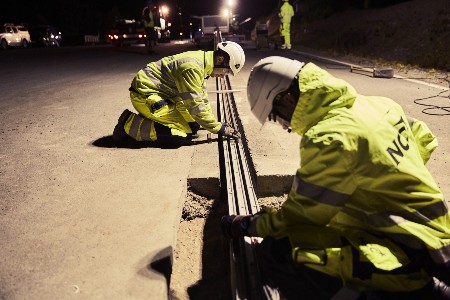The title of this posting isn’t describing a technology we haven’t seen before. After all, if you ever road in a bumper car at a county fair each was equipped with a small electric motor and vertical arm that contacted the roof, the power source. And there are electric trains, subways and light-rail cars today in cities all over the world that use electric power delivered through overhead wires or contact rails. So why not a road equipped to power EVs while on it.
Electric vehicles (EVs) use onboard batteries to provide the energy they need to operate. The EV batteries have two limiting properties. The first is they only hold a limited charge whether that gives the operator 200, 300, 400, or more kilometres of range. The second is at some point they have to be hooked up to a recharger which means downtime.
But what if the road was the source of continuous power so that the EV would never lose battery charge when riding on it. If roads had this type of technology, then only when an EV went off them would it be using its onboard battery. I could imagine getting off the main roadway to switch to battery power for the last few kilometres to get home.
eRoadArlanda, a Swedish project, is trying to make the above a reality. Its project is a two-year test by the Swedish Transport Administration (STA). Why do this? Because 33% of Sweden’s carbon emissions come from road transportation which is expected to increase by 59% in less than ten years. The STA believes the electrification of 2 to 4% of its road network would reduce fossil fuel consumption in the country by 3 million tons annually, which means reduced emissions by 80 to 90%.
eRoadArlanda uses an electrified rail embedded in the road surface. Vehciles equipped with a sensor to detect the rail would then lower a movable arm which would make contact. The rail would be powered through the conventional power grid or could conceivably use solar panels adjacent to roadways as an off-grid energy source. Any EV if equipped with the sensor and remote arm would be able to connect.
The design allows for existing road infrastructure to easily be converted. The initial pilot project involves a two-kilometre section of road and was launched in 2018. A PostNord battery-powered freight truck was the guinea pig. It was outfitted with sensor and arm. If needed, it easily could disconnect or reconnect with the rail in the face of heavy traffic or poor weather conditions.
The rail and on-vehicle sensor and arm technology can handle obstacles on the road using front-viewing radar similar to what is found on many vehicles today. Small pieces of gravel that may lie or lodge on the rail surace are easily avoided by the flexible arm mechanism which detaches and reattaches to the rail easily. Nor is the rail configuration a danger to bicycles or motorcycles when driving on the roadway. There is nothing to get caught in like a streetcar track because the contract rail lies flush to the road surface and provides similar traction to a concrete or asphalt surface.
The conduction rail is rainproof and has a tested patented solution for dealing with snow and ice. The STA has also taken into consideration any risk to animals or humans that may inadvertently contact the embedded rail. It notes that humans contacting the rail would not receive a shock because the system is designed to provide power only in proximity to a passing vehicle. Anyone standing directly on the road at that moment would be in greater danger of being hit by the vehicle than receiving a shock. A vehicle at low speed will not trigger the rail’s current. Nor will parked and in contact with the rail. As a final safety consideration, should there be a break in the rail circuit, the power automatically shuts down to adjacent road sections.
The initial cost of electrifying the 2-kilometre test came to $2.4 million USD. For the conceived 20,000-kilometre road network the STA wants to electrify, that cost should come down considerably. It estimates the cost of electricity to run the completed road network would amount to $1.2 billion USD annually. Savings once completed would equal $3.8 billion annually with the electrified road paying for itself within 3 years assuming saved fuel costs, construction and maintenance.
For heavy trucks, electrified roads make sense. The electric power needed to transport goods would quickly drain battery packs. The same is true for continuous use transit vehicles like buses and taxicabs which confined to conventional EV battery packs would have to stop for frequent recharges daily. So it would seem that an EV-charging road system has merits.
















